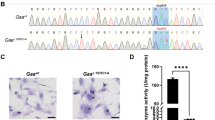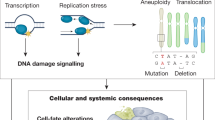Abstract
The inherited disease Lesch–Nyhan syndrome, which is caused by a deficiency of the enzyme hypoxanthine phosphoribosyltransferase (HPRT), is characterized by behavioural alterations, including self–injurious behaviour and mental retardation. Although HPRT–deficient mice have been generated using the embryonic stem cell system, no spontaneous behavioural abnormalities had been reported. We examined whether mice were more tolerant of HPRT deficiency because they were more reliant on adenine phosphoribosyltransferase (APRT) than HPRT for their purine salvage. The administration of an APRT inhibitor to HPRT–deficient mice induced persistent self–injurious behaviour. This combined genetic and biochemical model will facilitate the study of Lesch–Nyhan syndrome and the evaluation of novel therapies.
This is a preview of subscription content, access via your institution
Access options
Subscribe to this journal
Receive 12 print issues and online access
$209.00 per year
only $17.42 per issue
Buy this article
- Purchase on Springer Link
- Instant access to full article PDF
Prices may be subject to local taxes which are calculated during checkout
Similar content being viewed by others
References
Lesch, M. & Nyhan, W.L. A familial disorder of uric acid metabolism and central nervous system function. Am. J. Med. 36, 561–570 (1964).
Davidson, B.L. et al. Identification of 17 independent mutations responsible for human hypoxanthine-guanine phosphoribosyltransferase (HPRT) deficiency. Am. J. hum. Genet 48, 951–958 (1991).
Fujimori, S., Davidson, B.L., Kelley, W.N. & Palella, T.D. Identification of a single nucleotide change in the hypoxanthine-guanine phosphoribosyltransferase gene (HPRTYale) responsible for Lesch-Nyhan syndrome. J. clin. Invest. 83, 11–13 (1989).
Gibbs, R.A., Nguyen, P.N., McBride, L.J., Koepf, S.M. & Caskey, C.T. Identification of mutations leading to the Lesch-Nyhan syndrome by automated direct DNA sequencing of in vitro amplified cDNA. Proc. natn. Acad. Sci. U.S.A. 86, 1919–1923 (1989).
Keough, D.T., Gordon, R.B., de Jersey, J. & Emmerson, B.T. Biochemical basis of hypoxanthine-guanine phosphoribosyltransferase deficiency in nine families. J. inher. metab. Dis. 11, 229–238 (1988).
Sinnett, D. et al. Lesch-Nyhan syndrome: molecular investigation of three French Canadian families using a hypoxanthine-guanine phosphoribosyltransferase cDNA probe. Hum. Genet. 81, 4–8 (1988).
Lake, C.R. & Ziegler, M.G. Lesch-Nyhan syndrome: low dopamine-β-hydroxylase activity and diminished sympathetic response to stress and posture. Science 196, 905–906 (1977).
Lloyd, K.G. et al. Biochemical evidence of dysfunction of brain neurotransmitters in the Lesch-Nyhan syndrome. New Engl. J. Med. 305, 1106–1111 (1981).
Mueller, K., Saboda, S., Palmour, R. & Nyhan, W.L. Self-injurious behavior produced in rats by daily caffeine and continuous amphetamine. Pharmacol. Biochem. Behav. 17, 613–617 (1982).
Lloyd, K.G. & Stone, T.W. Chronic methylxanthine treatment in rats: a comparison of Wistar and Fischer 344 strains. Pharmacol. Biochem. Behav. 14, 827–830 (1981).
Peters, J.M. Caffeine-induced hemorrhagic automutilation. Arch. Int. Pharmacodyn. 169, 139–146 (1967).
Minana, M.D., Portoles, M., Jorda, A. & Grisolia, S. Lesch-Nyhan syndrome, caffeine model: increase of purine and pyrimidine enzymes in rat brain. J. Neurochem. 43, 1556–1560 (1984).
Razzak, A., Fujiwara, M., Oishi, R. & Ueki, S. Possible involvement of a central noradrenergic system in automutilation induced by clonidine in mice. Japan J. Pharmacol. 27, 145–152 (1977).
Ushijima, I., Katsuragi, T. & Furukawa, T. Involvement of adenosine receptor activities in aggressive responses produced by clonidine in mice. Psychopharmacol. 83, 335–339 (1984).
Breese, G.R., Criswell, H.E., Duncan, G.E. & Mueller, R.A. A dopamine deficiency model of Lesch-Nyhan disease − the neonatal-6-OHDA-lesioned rat. Brain Res. Bull. 25, 477–484 (1990).
Goldstein, M. Dopaminergic mechanisms in self-inflicting biting behavior. Psychopharmacol. Bull. 25, 349–352 (1989).
Jinnah, H.A., Gage, F.H. & Friedmann, T. Animal models of Lesch-Nyhan syndrome. Brain Res. Bull. 25, 467–475 (1990).
Hooper, M., Hardy, K., Handyside, A., Hunter, S. & Monk, M. HPRT-deficient (Lesch-Nyhan) mouse embryos derived from germline colonization by cultured cells. Nature 326, 292–295 (1987).
Kuehn, M.R., Bradley, A., Robertson, E.J. & Evans, M.J. A potential animal model for Lesch-Nyhan syndrome through introduction of HPRT mutations into mice. Nature 326, 295–298 (1987).
Dunnett, S.B., Sirinathsinghji, D.J.S., Heavens, R., Rogers, D.C. & Kuehn, M.R. Monoamine deficiency in a transgenic (Hprt−) mouse model of Lesch-Nyhan syndrome. Brain Res. 501, 401–406 (1989).
Finger, S., Heavens, R.P., Sirinathsinghji, D.J.S., Kuehn, M.R. & Dunnett, S.B. Behavioral and neurochemical evaluation of a transgenic mouse model of Lesch-Nyhan syndrome. J. Neurol. Sci. 86, 203–213 (1988).
Jinnah, H.A., Gage, F.H. & Friedmann, T. Amphetamine-induced behavioral phenotype in a hypoxanthine-guanine phosphoribosyltransferase-deficient mouse model of Lesch-Nyhan syndrome. Behav. Neurosci. 105, 1004–1012 (1991).
Williamson, D.J., Hooper, M.L. & Melton, D.W. Mouse models of hypoxanthine phosphoribosyltransferase deficiency. J. inher. metab. Dis. 15, 665–673 (1992).
Moyer, J.D. & Henderson, J.F. Salvage of circulating hypoxanthine by tissues of the mouse. Can. J. Biochem. cell Biol. 61, 1153–1157 (1983).
Brosh, S., Sperling, O., Bromberg, Y. & Sidi, Y. Developmental changes in the activity of enzymes of purine metabolism in rat neuronal cells in culture and in whole brain. J. Neurochem. 54, 1776–1781 (1990).
Rosenbloom, F.M., Kelley, W.N., Miller, J., Henderson, F. & Seegmiller, J.E. Inherited disorder of purine metabolism: correlation between central nervous system dysfunction and biochemical defects. J. Am. med. Assoc. 202, 175–177 (1967).
Leese, H.J. et al. Proflies of hypoxanthine guanine phosphoribosyl transferase and adenine phosphoribosyl transferase activities measured in single preimplantation human embryos by high-performance liquid chromatography. J. Reprod. Pert. 91, 197–202 (1991).
Moore, T.F. & Whittingham, D.G. Imprinting of phosphoribosyltransferases during preimplantation development of the mouse mutant, Hprtb-m3. Development 115, 1011–1016 (1992).
Szybalska, E.H. & Szybalski, W. Genetics of human cell lines, IV. DNA-mediated heritable transformation of a biochemical trait. Proc. natn. Acad. Sci. U.S.A. 48, 2026–2034 (1962).
Williamson, D.J. et al. Analysis of forebrain dopaminergic pathways in HPRT-mice. Adv. Exp. med. Biol. 309B, 269–272 (1991).
Breese, G.R. et al. Behavioral differences between neonatal and adult 6-hydroxydopamine-treated rats to dopamine agonists: relevance to neurological symptoms in clinical syndromes with reduced brain dopamine. J. Pharmcol. exp. Ther. 231, 343–354 (1984).
Fray, P.J., Sahakian, B.J., Robbins, T.W., Koob, G.F. & Iversen, S.D. An observational method for quantifying the behavioural effects of dopamine agonists: contrasting effects of d-amphetamine and apomorphine. Psychopharmacol. 69, 253–259 (1980).
Lewis, M.H., Baumeister, A.A., McCorkle, D.L. & Mailman, R.B. A computer-supported method for analyzing behavioral observations: studies with stereotypy. Psychopharmacol. 85, 204–209 (1985).
Bulfield, G., Siller, W.G., Wight, P.A.L. & Moore, K.J. X chromosome-linked muscular dystrophy (mdx) in the mouse. Proc. natn. Acad. Sci. U.S.A. 81, 1189–1192 (1984).
Stedman, H.H. et al. The mdx mouse diaphragm reproduces the degenerative changes of Duchenne muscular dystrophy. Nature 352, 536–539 (1991).
Snouwaert, J.N. et al. An animal model for cystic fibrosis made by gene targeting. Science 257, 1083–1088 (1992).
Dorin, J.R. et al. Cystic fibrosis in the mouse by targeted insertional mutagenesis. Nature 359, 211–215 (1992).
Tybulewicz, V.L.J. et al. Animal model of Gaucher's disease from targeted disruption of the mouse glucocerebrosidase gene. Nature 357, 407–410 (1992).
Lee, E.Y.-H. et al. Mice deficient for Rb are nonviable and show defects in neurogenesis and haematopoiesis. Nature 359, 288–294 (1992).
Jacks, T. et al. Effects of an Rb mutation in the mouse. Nature 359, 295–300 (1992).
Clarke, A.R. et al. Requirement for a functional Rb-1 gene in murine development. Nature 359, 328–330 (1992).
Donehower, L.A. et al. Mice deficient for p53 are developmental^ normal but susceptible to spontaneous tumours. Nature 356, 215–221 (1992).
Simmonds, H.A. 2,8-Dihydroxyadenine lithiasis. Clin. Chim. Acta 160, 103–108 (1986).
Smith, A.G. Culture and differentiation of embryonic stem cells. J. tiss. cult. Meth. 13, 89–94 (1991).
Author information
Authors and Affiliations
Rights and permissions
About this article
Cite this article
Wu, CL., Melton, D. Production of a model for Lesch–Nyhan syndrome in hypoxanthine phosphoribosyltransferase–deficient mice. Nat Genet 3, 235–240 (1993). https://doi.org/10.1038/ng0393-235
Received:
Accepted:
Issue Date:
DOI: https://doi.org/10.1038/ng0393-235
This article is cited by
-
Genome editing and genetic engineering in livestock for advancing agricultural and biomedical applications
Mammalian Genome (2017)
-
Reduced levels of dopamine and altered metabolism in brains of HPRT knock-out rats: a new rodent model of Lesch-Nyhan Disease
Scientific Reports (2016)
-
Experimental Models for Autism Spectrum Disorder Follow-Up for the Validity
Review Journal of Autism and Developmental Disorders (2016)
-
From Molecules to Behavior: Lessons from the Study of Rare Genetic Disorders
Behavior Genetics (2011)
-
Repetitive Self-Grooming Behavior in the BTBR Mouse Model of Autism is Blocked by the mGluR5 Antagonist MPEP
Neuropsychopharmacology (2010)



